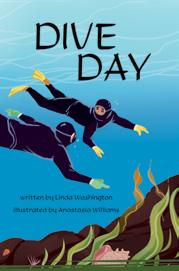MODULE 1 | THE SEA


BOOK SUMMARY
Like her mother before her, 76-year-old Ok-sun in Dive Day is a Haenyeo, a free-diving “sea woman” of South Korea’s Jeju Island. For generations women such as Ok-sun have made a living by harvesting seafood from the ocean floor. Ok-sun begins her day before sunrise. At the shore, she puts on her wetsuit and weighted belt and collects her net, buoy, and tools. At the dive site, Ok-sun and her diving partner, Sung-min, know just how deep they can dive and how much pressure they can endure as they search for abalone, conch, and octopus. Between dives, the women surface with whistle-like sounds called sumbisori, a vital breathing technique. After a full day and multiple dives, the women return to shore to sort and weigh their catch, setting aside a portion to sell. As the sun sets, the women sing and share a meal of fresh seafood.
WORLD KNOWLEDGE
✔ The country of South Korea occupies the southern part of the Korean peninsula in Asia.
✔ Women from Jeju Island began diving for food roughly 1,000 years ago.
✔ The Haenyeo are female divers of Jeju Island who do not use oxygen tanks and can hold their breath for one minute when diving.
WORD KNOWLEDGE
DECODING PATTERNS
bonus letters
consonant blends
FLUENCY PRACTICE
What fluency challenges do you hear when your students read? Use the supports below to plan targeted exercises for practice.
FOCUS PURPOSE
ACCURACY
Do students accurately decode most words? If not, are there error patterns?
practicing phonics: digraphs
INSTRUCTIONAL SUPPORT
• Review the digraphs ck and sh
• Instruct students to listen and look for the digraphs as you read aloud a passage.
• Instruct students to identify words with digraphs. Provide feedback as needed.
• Choral Read the passage.
• Instruct students to partner read and to provide each other with feedback about their accuracy.
PHRASING
Do students chunk words together into meaningful phrases as they read?
noticing periods
EXPRESSION
Do students demonstrate understanding of the text through proper expression?
reading dialogue
• Review the use of a period to show the end of a complete thought.
• Read the passage aloud, modeling appropriate pausing after each period.
• Instruct students to explain how pausing at each period makes the passage easier to understand.
• Echo Read the selected passage, pausing after each period, as students point to each period.
• Instruct students to partner read the passage, self-correct if needed, and share feedback about pausing for periods.
• Review how quotation marks show the words that a character speaks.
• Add expression to the dialogue while reading the passage aloud as students point to the quotation marks that show each piece of dialogue.
• Echo Read the passage, listening for expressive reading of the dialogue and providing feedback as needed.
• Instruct students to partner read, taking turns with the roles of the characters and providing each other with feedback.
PRACTICE PASSAGES
chapter 3, pages 22–25 back fish hush kick rocks sucks
chapter 5, pages 52–55 back check luck
chapter 1, pages 1–3
chapter 5, pages 50–52
chapter 1, page 10 chapter 5, page 54

WORKBOOK PRACTICE – COMPREHENSION
What comprehension challenges are your students facing? Use the targeted activities below for practice.
ACTIVITY PURPOSE ASSIGN
Read and Answer, page 10 analyzing text after chapter 4
Character Sketch, page 12 describing characters after first full read
list the Steps, page 14 sequencing events after first full read
Prepare to discuss, page 16 applying knowledge after first full read
Journal Prompt, page 18 writing to express knowledge after first full read
INSTRUCTIONAL SUPPORTS AND EXTENSIONS
• Support: Read the passage on page 10 together. Instruct students to work with a partner and to circle the parts that help them answer the question. Then facilitate a brief discussion about the question to help students generate their responses.
• extension: After completing the activity, instruct students to reread pages 38–47 of Dive Day. Ask this question: Why does Ok-sun decide to catch the abalone but not the octopus?
• Support: Instruct students to re-read chapters 4–5 with a partner and to jot examples of how Ok-sun is strong and kind.
• extension: Instruct students to identify another character trait that describes Ok-sun. Prompt students to find text evidence to support the character trait.
• Support: Instruct students to review the text and to generate a list of steps on a dive. Tell students to put their list in order. Then instruct them to work with a partner to decide which are the most important dive steps to include in the chart.
• extension: After students complete the activity, facilitate a brief discussion of these questions: How do the divers work together during each step of the dive? Why is it important that they work together?
• Support: Instruct students to review the text with a partner. Prompt students to discuss why the divers have rules about what to pick. Instruct students to use sticky notes to annotate examples of these rules in the text.
• extension: After completing the activity, plan 10–15 minutes for small groups to discuss the question on page 16. Then provide time for students to draw a picture that represents one of the dive rules. Invite students to share their pictures with a partner.
• Support: Model how to use the sentence frames to respond to the journal prompt.
• extension: After students complete the activity, instruct them to share their responses with a partner and to discuss which parts of the text helped them write their journal entries.

